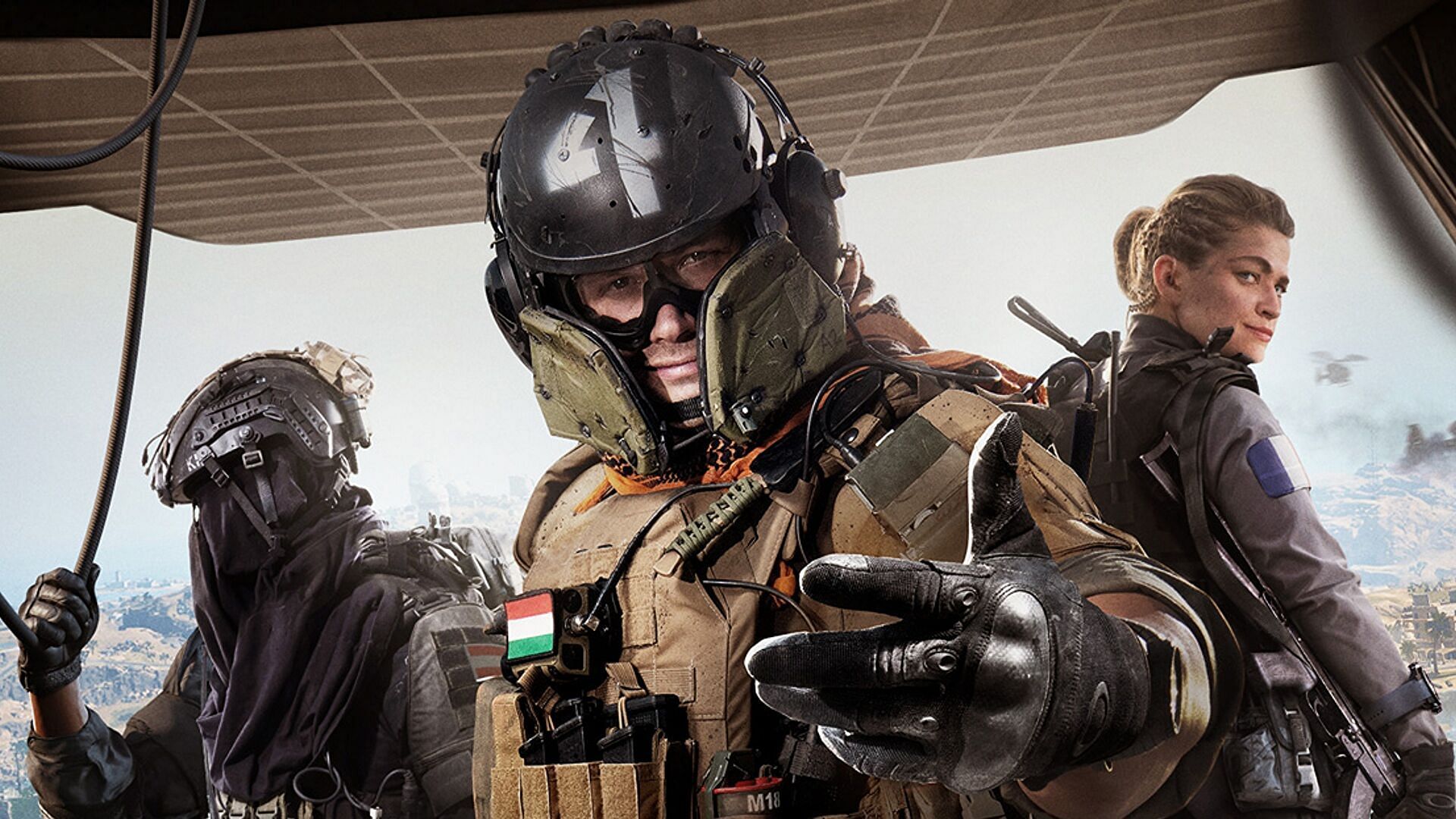Futuristic Military Uniforms - The U.S. Army currently employs a system called Blue Force Tracker (BFT). The system enables a commander to get a real-time picture of the battlefield from his or her personal computer. The commander can then track individual unit movement and provide this information to friendly units.
The U.S. Marines have used BFT, although they initially opted for a more portable and rugged system called the Enhanced Position Location Reporting System, or "ePLRS." Both ePLRS and BFT share the same goal: real-time tracking of friendly forces.
Futuristic Military Uniforms

The downside to both systems, however, is that they are bulky, somewhat dated and require computers with operators who could otherwise be carrying a weapon. Other commenters took exception to the pants being a different color.
New “Ike Jacket”
And many seemed to agree with a commenter on the Space Force's Facebook page who posted an image from Battlestar Galactica, saying the new uniform echoes the series. The person also added one of the show's taglines: "So say we all."
At the moment, the U.S. military is still playing catching up: The Army is currently in the process of sussing out requirements for a brand-new exoskeleton to help soldiers ruck faster and harder while reducing fatigue.
Whether they can catch up to the speed of Russian developments remains to be seen. "Think of yourself on steroids, holding as much weight as you want for as long as you want," said Atkinson. "It will also allow a 90 pound male or female to carry a 250 pound male or female off of the battlefield and it wouldn't feel like they were carrying 250 pounds worth of person."
The newly unveiled uniforms are "service dress" — the military equivalent to a coat and tie and a notch below full, formal or dinner dress. But a commenter on the Space Force subreddit says that for that purpose, "this is way over the top," suggesting that the uniforms seem too formal and constricting.

Got It Right
"It is absurd that we are forcing service members to fork over thousands of dollars in order to pay for necessary clothing items that they wear while serving our country," Hassan said in a statement in October when introducing the bill.
"This disparity in uniform costs is particularly stark for women, who are in some cases paying almost twice as much for the same uniform item as their male counterparts." Indeed, the feasibility of the Sotnik is directly related to the success of the Ratnik, according to Bendett, so far that the 'integrated systems for exchanging information' element that Ozdoev highlighted "is also not new and will probably build on" existing tactical systems
currently in service. And instead of resembling anything from a long time ago in a galaxy far, far away – the Army's adopted pinks and greens that were worn by the Greatest Generation during the Second World War.
It was actually a year ago that the Army rolled out its long-awaited update to its uniform wear guidelines. The revised AR 670-1 had last been updated in 2017. Indeed, the Pentagon has been pursuing the dream of a powered exoskeleton for nearly a half-century, with its latest effort, U.S.
Special Operations Command's Tactical Assault Light Operator Suit (TALOS), failing to yield a fully-integrated suit of combat armor following its unveiling in 2019. The Future Force Warrior setup is a significant improvement on these current systems.
A computer embedded in the suit and located at the base of the soldier's back will be connected to a local and wide-area network, allowing for data transfer. While Rosetec isn't explicitly saying how long research and development will take for the Sotnik combat suit, the company has "a lot to build on" now that two generations of Ratnik battle armor have been combat-tested by Russian forces, Bendett said.

While the prospect of a futuristic battle suit capable of shrugging off a .50 caliber round seems like something out of science fiction, the Russian military is "totally serious about this," said Samuel Bendett, a research analyst focused on Russian military developments at the
Center for Naval Analyses. Another vital component of battle is communication between soldiers. The Future Force Warrior will use sensors that measure vibrations of the cranial cavity, eliminating the need for an external microphone. This bone-conduction technology allows soldiers to communicate with one another, and it also controls the menus visible through the drop-down eyepiece.
The helmet has 360-degree situational awareness and voice amplification. The six buttons symbolize the Space Force's status as the sixth branch of the U.S. military, Raymond said Tuesday, as two guardians — the name for Space Force service members — modeled the uniform at the Air Force Association's Air, Space & Cyber Conference at National Harbor, Md.
Soldiers began wearing the Army Green Service Uniform (AGSU) after senior leaders approved it for everyday wear in late 2018, when it officially replaced the blue Army Service Uniform (ASU). Soldiers will still have until Oct.
1, 2027 to purchase the AGSU, after which the ASU will become the Army's optional dress uniform. The chief of space operations, Gen. John Raymond, stands between two Space Force guardians as the branch unveils prototypes for its new service dress uniforms.
Air Force Association hide caption The uniform was dubbed "pink and greens" by service members in the 1940s as the pair of pants often had a pink hue. The new uniform consists of a green jacket, khaki (not actually pink) pants, a khaki dress shirt and brown oxford shoes.

In addition, soldiers are now supplied matching socks, a tie and garrison cap, the flat and straight-sided foldable hat. "What this will allow you to do is to know where that sniper round or mortar round came from, but at the same time it will cancel out noise at a certain decibel so as not to cause damage to the soldier's ears," said Robert Atkinson.
, liaison sergeant, operational forces interface group, Natick Soldier Center. Actor Grace Park wears her Battlestar Galactica uniform in New York City. The costume is drawing comparisons to the U.S. Space Force's new uniforms. Jeffrey Ufberg/WireImage
hide caption Eisenhower had been impressed by the waist-cropped style jacket that was first worn by Maj. gen. Ira C. Eaker of VII Bomber Command in England. Eaker had modeled the jacket after the standard British "battledress" uniform worn during World War II.
Eaker reportedly gave his jacket to Eisenhower, who had similar jackets produced for wear in Europe. The value of enemy reconnaissance depends on how quickly that information can be relayed to the soldier on the battlefield.
The soldiers of the future will have more information immediately available to them than ever before. With the development of a bionic uniform for its soldiers, the U.S. Army is planning for a change in the logistics of war.
Integrated physiological monitoring, enhanced communication and augmented physical strength will give the soldiers of the future the tools they need to overwhelm their opponents simply by donning a hi-tech suit. In addition, enlisted service members receive a uniform when they enter the military and an annual clothing allowance after that to replace items.

However, officers generally receive a $400 clothing allowance when they first report for active duty, yet do not receive an annual stipend for replacements. The Army had previously estimated its new Army Green Service Uniform dress coat would cost about $163 for enlisted women and $82 for enlisted men.
Not only will Future Force Warriors know more about their fellow soldiers, but they will also know more about their own physiological condition. The physiological subsystem of the uniform lies against the soldier's skin and includes sensors that monitor the soldier's core body temperature, skin temperature, heart rate, body position (standing or sitting) and hydration levels.
These statistics are monitored by the soldier and by medics and commanding officers who may be miles away. Knowing the condition of a platoon of soldiers allows commanders to make better strategic decisions. The Future Force Warrior helmet also includes a GPS receiver, providing commanders with exact positioning data on their troops.
"The new generation gear will consist of a fundamentally new set of technology, including the latest achievements of the Russian defense industry, including robotic equipment and integrated systems for exchanging information," according to Rostec's Bekkhan Ozdoev.
"Today we have started the first stage of development - the definition of tactical and technical requirements." There are two phases to the Future Force Warrior program. The first phase involves the deployment of a uniform in 2010 that will meet the Army's short-term needs, although pieces of the uniform may be deployed earlier.
According to Future Force Warrior Equipment Specialist Jean-Louis "Dutch" DeGay, "The Department of the Army has built what's called design spirals, so roughly every two years, if a piece of technology has matured, we try to get it in the field

, rather than waiting until 2010 to field the entire system." In 2020, the U.S. Army will roll out a suit that integrates nanotechnology, exoskeletons and liquid body armor, all of which exist only in concept now.
Powering the entire suit is a 2- to 20-watt microturbine generator fueled by a liquid hydrocarbon. A plug-in cartridge containing 10 ounces of fuel can power the soldier's uniform for up to six days. Battery patches embedded in the helmet provide three hours of back-up power.
As warfare changes, armies are looking for any advantage they can get against potential enemies. The new Future Force Warrior suit will take human performance to unprecedented levels. Imagine a platoon of soldiers wearing suits that turn an ordinary person into a real, live superhero.
Army recruiters and drill sergeants had been among the very first soldiers to receive the uniforms in late 2020, as they were typically considered the face of the Army. Fort Sill, OK, had been the very first training location to issue the AGSU, followed by Fort Leonard Wood, MO, and then Fort Benning, GA.
By Jared Keller | Published Feb 1, 2021 2:02 PM EST The Space Force uniform combines a dark blue jacket with gray pants. Its buttons prominently feature the delta shape that the service adopted soon after its creation — and which has frequently been compared to the Starfleet emblem from the venerable Star Trek franchise.
While Rostec's official release was vague regarding the specifics of the new system, Ozdoev had previously stated the fourth-generation Sotnik armor will consist of lightweight polyethylene fiber and armor plating that is engineered to withstand a direct shot from a .50 caliber M2 Browning.
"The gear will not restrict movement and will allow you to take the extra weight necessary to perform special missions," according to Ozdoev. The U.S. Space Force unveiled prototypes for its new service dress uniforms at this year's Air, Space & Cyber Conference.
Air Force Association hide caption MR fluid will fill small pockets in the Future Force Warrior uniform fabric. The uniforms will be wired to allow an electrical current to pass through the fabric. The electrical current will be controlled by the onboard computer system and will automatically charge the MR fluid when there is a ballistic threat present.
Jared Keller is the managing editor of Task & Purpose. His writing has appeared in Aeon, the Los Angeles Review of Books, the New Republic, Pacific Standard, Smithsonian, and The Washington Post, among other publications. Contact the author here.
future military uniforms, army uniforms for sale, futuristic army uniform, us army uniform guide, future army uniform, futuristic police uniform, us army uniforms, us army dress uniform
0 Comments